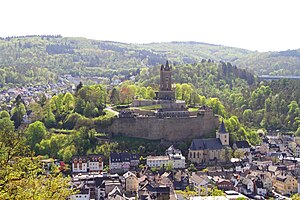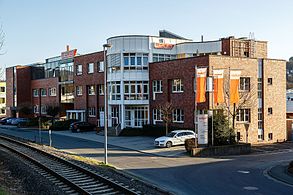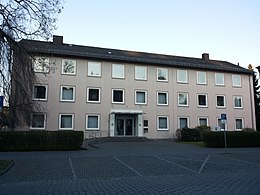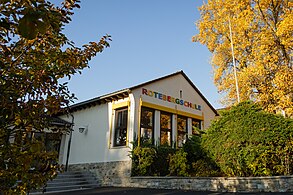Dillenburg
| coat of arms | Germany map | |
|---|---|---|

|
Coordinates: 50 ° 44 ' N , 8 ° 17' E |
|
| Basic data | ||
| State : | Hesse | |
| Administrative region : | to water | |
| County : | Lahn-Dill district | |
| Height : | 230 m above sea level NHN | |
| Area : | 83.89 km 2 | |
| Residents: | 23,209 (Dec. 31, 2019) | |
| Population density : | 277 inhabitants per km 2 | |
| Postcodes : | 35683-35690 | |
| Area code : | 02771 | |
| License plate : | LDK, DIL | |
| Community key : | 06 5 32 006 | |
| LOCODE : | DE DIB | |
| City structure: | 8 districts | |
City administration address : |
Rathausstrasse 7 35683 Dillenburg |
|
| Website : | ||
| Mayor : | Michael Lotz ( CDU ) | |
| Location of the city of Dillenburg in the Lahn-Dill district | ||
The Oranienstadt Dillenburg is a city in the Lahn-Dill district in central Hesse . The city is a middle center and was formerly the district town of the Dill district , which is now part of the Lahn-Dill district.
The city is the starting point of the Rothaarsteig long-distance hiking trail and is located on the German-Dutch holiday route Oranier Route and the German half-timbered road .
On November 1, 2017, the Hessian Minister of the Interior and for Sport, Peter Beuth , gave the city the city name extension "Oranienstadt". According to Paragraph 13, Paragraph 2 of the Hessian Municipal Code, the new name is an integral part of the municipality name (to be compared with “am Main” near Frankfurt am Main ). This refers to the outstanding historical position of Dillenburg as the headquarters of the Orange branch of the House of Nassau . William of Orange , the "father" of the Netherlands, was born in Dillenburg.
geography
Geographical location
The Oranienstadt Dillenburg is located in the Dill Valley along the Dill and the Dietzhölze that flows north of the city, while the Nanzenbach and Schelde tributaries from the Schelder Forest flow in the south of the city . The dill represents the interface between the Westerwald in the west and the Gladenbacher Bergland in the east, to which the Scheldt Forest also belongs. To the northwest of the city, between Dill and Dietzhölze, the Struth rises as the foothills of the Rothaargebirge . The Galgenberg , located in the city of Dillenburg, between the city center and the Manderbach district , can be seen as the southernmost elevation of the Rothaargebirge.
Neighboring communities
Dillenburg borders in the north on the municipality of Eschenburg , in the east on the municipality of Siegbach , in the south on the city of Herborn and the municipality of Breitscheid and in the west on the city of Haiger . All neighboring communities are in the Lahn-Dill district in the state of Hesse.
City structure
Dillenburg is made up of the city center and the districts of Donsbach , Eibach , Frohnhausen , Manderbach , Nanzenbach , Niederscheld and Oberscheld .
history
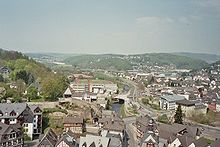
City view to the north from the Wilhelmsturm
|
The first documentary mention was in 1254. Only 90 years later, in 1344, Dillenburg received city rights from Emperor Ludwig IV the Bavarians .
Dillenburg was the ancestral seat of the Orange branch of the House of Nassau . The Dillenburg was built on today's Schlossberg at the end of the 13th and beginning of the 14th century. This castle was of great importance for the House of Nassau because, unlike Herborn Castle, it was not a fiefdom of the Landgraves of Hesse , but an own castle. There are no pictures of this castle as it was probably made of wood and was destroyed in the Dernbach feud around 1323.
In the 16th century, the main residence of the Counts of Nassau-Dillenburg was built on the site of the old castle with the Dillenburg Castle , which from 1536 was expanded into a modern fortress at the same time. From exile in the castle, William of Orange, who was born in Dillenburg, organized the Netherlands' resistance against Spain (1567–1572), which still connects the Dutch royal family with the city today. The land was administered by a President of the Nassau-Dillenburg government. One of the last presidents was Georg Ernst Ludwig Freiherr von Preuschen von und zu Liebenstein .
A city fire devastated large parts of the city in 1723. More than 200 buildings fell victim to the flames. Many of the half-timbered houses that were built after the fire are still standing today.
In the Seven Years' War , the Dillenburg Castle in 1760 was destroyed. The buildings on Wilhelmstrasse were built from the remains of the castle. 8 June 2010 it was announced that the Wilhelmstrasse - such as also the Wilhelmsturm - henceforth the protection of the Hague Convention for the Protection of Cultural Property in the Event of Armed Conflict subject. The Hessian State Stud is located in Wilhelmstrasse .
The casemates under the former castle from the 16th century have been partially preserved and are among the largest underground defenses in Europe. The casemates provided quarters for over 2,000 soldiers in times of war. Some of them have been exposed again and can be walked on in a tour. They too - like the "Villa Grün" - are now subject to the Hague Convention.
In the Duchy of Nassau , Dillenburg was the seat of the Dillenburg office and the Dillenburg court .
In 1875, the Wilhelmsturm , today Dillenburg's landmark , was completed on the Schlossberg. The tower is supposed to commemorate William of Orange.
In the 19th century, the industrial revolution began with the construction of the Sieg-Dill route as part of the railway line from Giessen to Cologne . The region experienced an upswing through the use of iron ores found on the Lahn , Dill and Sieg . Numerous mining, metallurgy and metal processing operations were established. During this time, many branch lines starting from Dillenburg were built, including to Gönnern and Ewersbach . These routes have now been closed again. The route to Gönnern was closed in 1987 and completely dismantled. The depot , which was necessary for the many branch lines in the steam locomotive era , was closed in 1983.
During the Second World War , Dillenburg with its now disused marshalling yard was the target of Allied bombing raids. The ore mining became increasingly unprofitable after the Second World War. In 1968 the last blast furnace in the Oberscheld district ceased operations.
During a storm on September 17, 2006, 103 liters of rain fell on the square meter. The Dill and its tributary Scheldt overflowed their banks and in particular flooded the districts of Ober- and Niederscheld. Over 1000 cellars were full, and the district hospital was damaged and had to be partially evacuated. The total damage amounted to well over 20 million euros.
In 2007, the Schlossberg tunnel was opened as a bypass of the B 277 . This runs below the Schlossberg and thus bypasses the historic half-timbered old town.
Territorial history and administration
The following list gives an overview of the territories and administrative units to which Dillenburg was subordinate:
- before 1739: Holy Roman Empire , County / Principality of Nassau-Dillenburg , Dillenburg office
- from 1739: Holy Roman Empire, Principality of Nassau-Diez , Dillenburg Office
- 1806–1813: Grand Duchy of Berg , Department of Sieg , Canton of Dillenburg
- 1813–1815: Principality of Nassau-Orange , Dillenburg office
- from 1816: German Confederation , Duchy of Nassau , Dillenburg office
- from 1849: German Confederation, Duchy of Nassau, Herborn district office
- from 1854: German Confederation, Duchy of Nassau, Dillenburg Office
- from 1867: North German Confederation , Kingdom of Prussia , Province of Hessen-Nassau , Administrative Region of Wiesbaden , Dillkreis
- from 1871: German Empire , Kingdom of Prussia, Province of Hessen-Nassau, administrative district of Wiesbaden, Dillkreis
- from 1918: German Empire, Free State of Prussia , Province of Hessen-Nassau, Administrative Region of Wiesbaden, Dillkreis
- from 1932: German Empire, Free State of Prussia, Province of Hesse-Nassau, District of Wiesbaden, District of Dillenburg
- from 1933: German Reich, Free State of Prussia, Province of Hessen-Nassau, Administrative Region of Wiesbaden, Dillkreis
- from 1944: German Empire, Free State of Prussia, Nassau Province , Dill District
- from 1945: American occupation zone , Greater Hesse , Wiesbaden district, Dillkreis
- from 1949: Federal Republic of Germany , State of Hesse , Wiesbaden district, Dillkreis
- from 1968: Federal Republic of Germany, State of Hesse, administrative district Darmstadt , Dillkreis
- from 1977: Federal Republic of Germany, State of Hesse, Darmstadt administrative district, Lahn-Dill district
- from 1981: Federal Republic of Germany, State of Hesse, Gießen administrative district , Lahn-Dill district
Incorporations
In the course of administrative reform in Hesse , the community were on a voluntary basis on October 1, 1971 Eibach , the community at 31 December 1971 Manderbach and 1 April 1972, the municipality Nanzenbach to Dillenburg incorporated .
This was followed on January 1, 1977 by the previously independent communities of Donsbach , Frohnhausen , Niederscheld and Oberscheld through the law on the reorganization of the Dill district, the districts of Gießen and the district of Wetzlar and the cities of Gießen and Wetzlar .
Local districts with local advisory councils and local councilors were formed for all formerly independent municipalities and for the core city .
Population development
Until 1970, the figures relate only to the municipal capital Dillenburg. After that, the village communities that are now part of Dillenburg were incorporated with a delay. (Data from 1998 to December 31st)
|
|
|
||||||||||||||||||||||||||||||||||||||||||||||||||||||||||||||||||||||||||||||||||||
Swell:
politics
coat of arms
Description : in blue a golden tin tower with an erect golden lion in the great gate and a drawn silver grille .
City Council
The city council is the highest body of the city. Its political composition is determined every five years in local elections by the city's electorate. Whoever has reached the age of 18 and is a German citizen within the meaning of the Basic Law or a citizen of one of the other member states of the European Union may vote. Everyone has to have been registered in the city for at least three months.
The individual voter has the opportunity his votes on several candidates - including those of different electoral lists to distribute (- cross-voting ), or to pile on individual candidates ( cumulate ). To this end, the voter has as many votes as there are seats to be allocated. In the Dillenburg city council there are currently 37.
The local elections on March 6, 2016 produced the following results, compared to previous local elections:
| Nominations | CDU | SPD | GREEN | FDP | Citizens for Dillenburg |
REP | FWG | BL b | Distribution of seats | |
|---|---|---|---|---|---|---|---|---|---|---|
| 2016 | Voting share a | 46.9 | 29.7 | 11.3 | 8.0 | 4.1 | - | - | - |
 |
| Seats (of 37) | 17th | 11 | 4th | 3 | 2 | - | - | - | ||
| 2011 | Voting share a | 47.4 | 35.0 | 13.2 | 4.4 | - | - | - | - |
 |
| Seats (of 37) | 17th | 13 | 5 | 2 | - | - | - | - | ||
| 2006 | Voting share a | 51.4 | 31.0 | 6.1 | 3.6 | - | 4.5 | 3.5 | - |
 |
| Seats (of 37) | 19th | 12 | 2 | 1 | - | 2 | 1 | - | ||
| 2001 | Voting share a | 43.1 | 34.7 | 4.7 | 3.6 | - | 5.9 | 4.3 | 3.6 |
 |
| Seats (of 45) | 19th | 16 | 2 | 1 | - | 3 | 2 | 2 | ||
| 1997 | Voting share a | 31.1 | 32.6 | 8.1 | 2.8 | - | 11.7 | 7.5 | 6.2 |
 |
| Seats (of 45) | 14th | 15th | 4th | - | - | 5 | 4th | 3 | ||
37 city councilors and the city's local councils had to be elected for the legislative period from April 1, 2016 to March 31, 2021. Of 17,635 eligible voters, 6,639 went to vote. As a result, the turnout increased from 36.6% in 2011 to 37.6% in 2016.
At the end of 2019, the parliamentary group for Dillenburg dissolved. The MP Sabine Simon joined the CDU parliamentary group on February 20, 2020, which thus had 18 seats in the city council. The MP Otto Nickel remained independent as a non-attached MP.
Twin cities
In 1963 Dillenburg founded the “Union of Orange Cities” with the cities of Breda in the Netherlands, Diest in Belgium and Orange in France. These cities were important residences of the Orange branch of the House of Nassau.
It has been twinned with Hereford in Great Britain since 1989. From the Dillenburg side, the “German-English Society”, from the Hereford side, the “Twinning Association” maintains the partnership. The two clubs visit each other on an annual basis. In 2005 the town hall (branch of the town hall, for example with a tourist office, registration office) was renamed “Hereford House”.
Culture and sights
Mainly because of the Rothaarsteig , which starts and ends in Dillenburg, but also because of the historical references to the Netherlands, Dillenburg is a tourist destination.
Museums
In Dillenburg there is the Wilhelmsturm with the Oranien-Nassau Museum on the site of the Dillenburg Castle, which was destroyed in 1760, or the Villa Grün museum of economic history . The carriage museum in the orangery - "living museum" about horses - is located in the Hessian state stud .
Buildings
Well-known buildings in Dillenburg are for example the Wilhelmsturm from the years 1872–1875, the casemates of the Dillenburg Castle from the 16th century, the Protestant town church from 1491 and the Dill Tower from 1597. There is also the old rectory from the Years 1531–1533, the Untertor from 1344 ( renovation work in 1594 and 1737) and as an ensemble the historic old town with numerous half-timbered houses .
The Bismarck Temple ( ⊙ ), a 6 m high viewing pavilion built in 1885, stands on the vineyard northeast of the town center.
Parks
In Dillenburg there is the historic Hofgarten, in the district of Donsbach there is the Donsbach wildlife park .
Hiking and biking trails
Due to the low mountain range, Dillenburg is a junction of hiking trails that lead through the city or begin in it. The trails include the Rothaarsteig from Dillenburg to Brilon , the Schlösserweg from Dillenburg to Düsseldorf-Benrath , the Uplandweg from Dillenburg to Salzkotten , the Dill hiking trail from Haiger to Wetzlar , the Dill hiking trail (left the Dill) from the Dill source to Asslar and the Lahn-Dill-Bergland-Path from Dillenburg to Marburg . The approximately 25 kilometers long “Orange Path” runs around Dillenburg. The two “Lahn-Dill-Bergland extra tours” Kuckucksweg and Eschenburgpfad start in the districts of Eibach and Nanzenbach.
The Hessian long-distance cycle route R8 runs through Dillenburg from Frankenberg (Eder) via Limburg an der Lahn to Heppenheim .
Tourist routes
Dillenburg is on several scenic routes . The Lahntal - Rheingau section of the Deutsche Fachwerkstrasse begins in the old town . The 2,400 kilometer Orange Route , which crosses cities in the Netherlands and nine German federal states that are connected to the House of Orange-Nassau, also runs through Dillenburg .
Geocaching
In Dillenburg there are several geocaches that are known far beyond the city limits and lead geocachers from all over Germany to Dillenburg: "The victim of the railroad worker" won the "Lost Place competition 2014", is "Cache of the month 04/2014", "Plastic can of the month 04/2015" and listed under bettercacher.de . The cache series about the grandson of "Ferdinand Moritz Weber" are known nationwide and are also listed on bettercacher.de, as are many caches from the owner mr.checkmate . The 05/2017 issue of Geocaching Magazin pays tribute to Dillenburg and the surrounding area with a cover report - the Wilhelmsturm on the cover picture.
Regular events
The State Stud Hessen organizes a single horse tournament and various horse shows every year .
The Dillenburg Bach Week has been held annually since 1975 .
Since 2001, the so-called “Aquarena Night”, an open-air party in the city center with a shopping night and large fireworks, has been taking place in July. Further events are the cherry market in June and the Hubertus market in October.
Since 1978 the “Jazz Weekend” has taken place in June and attracted numerous music lovers to Dillenburg. Thousands of locals and guests populated the city center and the Schlossberg. This traditional event ended with the 33rd “Jazz Weekend” in 2010.
Since 2007 there has been the "medieval Schlossberg spectacle" on the Schlossberg around the Wilhelmsturm. On the last weekend in June, 30 army camps, 50 traders, knights, jugglers and minstrels fill the castle park with life from a bygone era.
Economy and Infrastructure
traffic
Several important traffic routes run through the Dill Valley. Dillenburg is connected to the federal autobahn 45 , the so-called "Sauerland line", via which the Rhine-Main area and the Ruhr area can be reached. Since the motorway runs above the Dill Valley, the Sechshelden Viaduct , the Marbachtal Bridge and the Lützelbachtal Bridge have been built in the Dillenburg area. Federal roads 253 and 277 also run through Dillenburg . The B 253 leads via Biedenkopf , Frankenberg and Fritzlar to Melsungen . The B 277 begins in the neighboring town of Haiger and leads via Herborn to Wetzlar . It is built like a motorway between Sechshelden and Dillenburg and between Dillenburg and Sinn . The high traffic load in the city center of Dillenburg from the B 277 led to the construction of the bypass with the Schlossberg tunnel , which now connects the two expanded sections of the B 277. The Dill line as a section of the Cologne-Giessen railway via Wetzlar and Siegen connects Central Hesse with the Rhineland and the Ruhr area . The Dillenburg station was once an important freight station due to iron mining in the Schelderwald .
The nearest international airports are Frankfurt am Main , 107 kilometers away, and Cologne / Bonn , 121 kilometers away. The traffic Siegerland airport is 22 kilometers away.
Established businesses
Cohline GmbH , Isabellenhütte Heusler GmbH & Co. KG, Weber Kunststofftechnik , Linde + Wiemann , Ströher-Keramik , Wendel Email and Stahlo Stahlhandels GmbH & Co. KG , a company of the Friedhelm Loh Group , have their headquarters in Dillenburg . Furthermore, Outokumpu Nirosta are located in the northern industrial area between the core city and the district Frohnhausen and EAM Energienetz-Mitte with a location in the district Oberscheld.
The German Telekom operates a data center in the area of the settlement area Galgenberg-Löhren.
media
- Dill-Post of the newspaper group Lahn-Dill
- Dill-Zeitung , since 2016 also newspaper group Lahn-Dill
Public facilities
- District Court Dillenburg
- Police station
- Volunteer firefighter
- Dill clinics ( hospital )
- Diaconal work
- DRK district association Dillkreis
- Youth Welfare Office of the Lahn-Dill District
- Youth education center of the Lahn-Dill district
- Lebenshilfe Dillenburg e. V.
- Social Office of the Lahn-Dill-Kreis
- Hessen Mobil location Dillenburg (district: Lahn-Dill-Kreis and Limburg-Weilburg)
- technical aid organization
education
The following schools exist in Dillenburg:
- Juliane von Stolberg School ( primary school )
- Johann von Nassau School ( secondary and secondary school )
- Wilhelm-von-Oranien-Schule ( grammar school )
- Commercial schools ( vocational school )
- Fachschule für Wirtschaft (vocational school with possible technical college entrance qualification )
- Otfried Preußler School for the Practically Formable ( Special School )
- Goldbachschule (secondary and secondary school)
- Schelderwald School (primary school)
- Rotebergschule (primary school)
- Lahn-Dill-Akademie ( adult education center )
- Four kindergartens (Protestant, Catholic, urban, workers welfare )
Personalities
Personalities who worked in Dillenburg
- Johann Daniel I Haas (1697–1765), stocking weaver, magistrate
- Wilhelm Heinrich Seel (1725–1798), German theologian
- Georg Ernst Ludwig Freiherr von Preuschen von und zu Liebenstein (1727–1794), Princely Oranien-Nassauer secret council and district president of Dillenburg
- Georg Ludwig Hartig worked as a forest master in Dillenburg from 1797 to 1806
- Conrad Heusler (1826–1907), German entrepreneur and mining official
- Friedrich Heusler (1866–1947), German mining engineer, chemist and discoverer of Heusler's alloys
- Otto Rudolf Haas (1878–1956), steel industrialist ( W. Ernst Haas & Sohn )
- Maximilian Mörlin , Protestant theologian and reformer
- Karl-Peter Chilla , church musician
- Rolf Krenzer , playwright, songwriter
- Paul Moses Schott (born June 22, 1882 in Frankfurt am Main; died 1936), grammar school teacher, removed from office by the National Socialists in 1933.
sons and daughters of the town
- Fritz Angerstein (1891–1925), industrialist and mass murderer
- Johannes von Arnoldi (1751–1827), archivist, historian, statesman
- Barbara Isabella Bauer-Heusler (* 1948), artist
- Catharina Helena Dörrien (1717–1795), pioneer of girls' education, painter, botanist
- Hans-Werner Eckert (* 1953), lawyer
- Karl Heinz Gasser (* 1944), politician
- Astrid Geisler (* 1974), journalist
- Beatrice Gleicher (* 1957), theater actress, singer, author and producer
- Johann Daniel Haas (1780–1849), tobacco manufacturer and member of parliament
- Rudolf Haas (1843–1916) hut owner, Privy Councilor of Commerce
- Carl Ludwig Heusler (1790–1851), entrepreneur and secret mountain ridge
- Michael Hoffmann (* 1967), master chef
- Julia Jung (* 1979), double European champion in swimming (TV Dillenburg)
- Peter Kleiss (* 1949), author and music editor
- Maria Kliegel (* 1952), German cellist
- Father Peter Kliegel (* 1939), Catholic pastor, honorary citizen of Chile
- Karl von Knoblauch zu Hatzbach (1756–1794), Nassau administrative lawyer and Enlightenment writer
- Gesa Felicitas Krause (* 1992), German athlete
- Matthias Kreck (* 1947), mathematician
- Rolf Krenzer (1936–2007), children's book author and musical composer
- Ingrid Kretz (* 1959), author and musical writer
- Paddy Kroetz (* 1978), reporter and television presenter
- Arnold Lequis (1861–1949), was a German officer and holder of the order Pour le Mérite
- Otfried Hans Freiherr von Meusebach alias John O. Meusebach (1812–1897), founder of Fredericksburg (Texas) and Senator from Texas
- Maurice of Nassau (1604-1679), Dutch Field Marshal, the Brazilians called
- Ernst Casimir von Nassau-Dietz (1573–1632), ancestor of the kings of the Netherlands
- Christian von Nassau-Dillenburg (1688–1739), Prince of Nassau-Dillenburg
- Johann VI. von Nassau-Dillenburg (1536–1606), Count of Nassau-Dillenburg, regent of the Nassau ancestral lands, governor of Gelderland
- Georg von Nassau-Dillenburg (1562–1623), Count of Nassau-Dillenburg
- Heinrich von Nassau-Dillenburg (1641–1701), Prince of Nassau-Dillenburg
- Johannetta Elisabeth von Nassau-Dillenburg (1593–1654), Countess from the House of Nassau-Dillenburg
- Moritz von Orange (1567–1625), governor of Holland, Zeeland, Utrecht, Geldern and Overijssel
- Wilhelm Ludwig von Nassau-Dillenberg (1560–1620), Count of Nassau-Dillenburg
- William I of Orange-Nassau (1533–1584), leader in the Dutch War of Independence against Spain
- Karl Christian Parcus (1763–1819), administrative lawyer and revolutionary
- John Potts (1776–1808), the only German participant in the Lewis and Clark expedition
- Kemal Rüzgar (* 1995), soccer player
- Carl Schenck (politician) (1805–1868), member of the Paulskirche and Speaker of the Nassau Parliament
- Adolph Schenck (1803–1878), Nassau entomologist
- Paul Arthur Schilpp (1897–1993), philosopher and Methodist clergyman
- Hermann Stahl (1908–1998), painter and writer
- Melanie Tatur (* 1944), political scientist and sociologist
- Luca Waldschmidt (* 1996), national soccer player
- Karl Witt (* 1923), football player
- Wilhelm Zepper (1550–1607), Reformed theologian, court preacher and professor in Herborn
Mayor of Dillenburg since 1945
- 1945–1954: Karl Fick , mayor before 1945; Elected freely in 1945
- 1954–1984: Gerhard Beermann
- 1984–1990: Manfred Fughe
- 1990–2002: Helmut Meckel , re-elected in 1996, for the first time again in direct election
- since 2002: Michael Lotz , CDU
Honorary citizen
- 1895: Otto von Bismarck , Reich Chancellor
- 1986: Charlotte Petersen , journalist
literature
- Randolf Fügen: Highlights in Central Hesse. Wartenberg Verlag, Gudensberg-Gleichen 2003, ISBN 3-8313-1044-0 , p. 9.
- Hermann-Josef Hucke (editor): Great Westerwaldführer. Westerwald-Verein e. V., 3rd edition. Montabaur 1991, ISBN 3-921548-04-7 , p. 542.
- Literature about Dillenburg in the Hessian Bibliography
- Search for Dillenburg in the SPK digital portal of the Prussian Cultural Heritage Foundation
- Search for Dillenburg in the archive portal-D of the German Digital Library
Web links
- Internet presence of the city of Dillenburg
- Dillenburg, Lahn-Dill district. Historical local dictionary for Hessen. (As of October 5, 2015). In: Landesgeschichtliches Informationssystem Hessen (LAGIS).
- Information on the community of Dillenburg. In: Hessisches Gemeindelexikon. HA Hessen Agentur GmbH , 2020.
- Link catalog on the subject of Dillenburg at curlie.org (formerly DMOZ )
Individual evidence
- ↑ Hessian State Statistical Office: Population status on December 31, 2019 (districts and urban districts as well as municipalities, population figures based on the 2011 census) ( help ).
- ↑ Dillenburg is Oranienstadt ( Memento from November 10, 2017 in the Internet Archive ) In: Website of the city of Dillenburg.
- ^ Print edition of the Dill newspaper June 8, 2011
- ↑ a b Dillenburg, Lahn-Dill district. Historical local dictionary for Hessen. (As of December 12, 2016). In: Landesgeschichtliches Informationssystem Hessen (LAGIS).
- ^ Michael Rademacher: German administrative history from the unification of the empire in 1871 to the reunification in 1990. State of Hesse. (Online material for the dissertation, Osnabrück 2006).
- ↑ K.-H. Gerstenmeier (1977): Hessen. Municipalities and counties after the regional reform. A documentation. Melsungen. P. 288. DNB 770396321
- ↑ Law on the restructuring of the Dill district, the districts of Gießen and Wetzlar and the city of Gießen (GVBl. II 330–28) of May 13, 1974 . In: The Hessian Minister of the Interior (ed.): Law and Ordinance Gazette for the State of Hesse . 1974 No. 17 , p. 237 ff ., § 24 ( online at the information system of the Hessian state parliament [PDF; 1,2 MB ]).
- ↑ main statute. (PDF; 21 kB) § 5. In: Website. City of Dillenburg, accessed February 2019 .
- ^ City of Dillenburg: Population figures.
- ^ Result of the municipal election on March 6, 2016. Hessian State Statistical Office, accessed in April 2016 .
- ↑ Hessian State Statistical Office: Results of the municipal elections of 2011 and 2006
- ↑ Hessian Statistical Office: Results of the municipal elections of 2001 and 1997
- ↑ Dillenburg: Defector brings CDU a majority. In: website. VRM Wetzlar GmbH, accessed February 2020 .
- ↑ Orange and twin cities. In: website. City of Dillenburg, accessed April 2019 .
- ^ German-English Society Dillenburg (DEG)
- ↑ Chronicle of the German-English Society Dillenburg (DEG)
- ↑ Bismarck tower Dillenburg on bismarcktuerme.de (note: height information on the slope side)
- ↑ The Hofgarten on the Dillenburg website
- ↑ Hiking trails in the Westerwald
- ↑ Geocaching Magazine - by cachers for cachers - single issues In: com / geocaching-magazin.com accessed on November 29, 2017.
- ^ Schools in Dillenburg. (PDF; 17 kB) In: Website. City of Dillenburg, accessed April 2019 .
- ^ Son of Sigmund Schott . Annual figures on Dillenburg's history. In: website. City of Dillenburg City history, accessed April 2019 .



